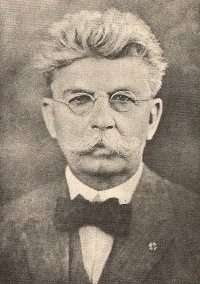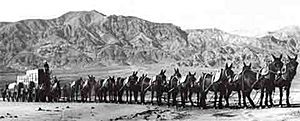Francis Marion Smith facts for kids
Quick facts for kids
Francis Marion Smith
|
|
|---|---|

Francis Marion "Borax" Smith
|
|
| Born | February 2, 1846 |
| Died | August 27, 1931 (aged 85) |
| Occupation | Mining businessman |
| Known for | Borax King, founder of Pacific Coast Borax Company |
| Spouse(s) | Mary Rebecca Thompson Wright (m. 1875) Evelyn Kate Ellis (m. 1906) |
Francis Marion Smith (February 2, 1846 – August 27, 1931) was a very important American businessman. People often called him "Borax Smith" or "The Borax King". He became famous for mining borax, a useful mineral, in the Mojave Desert and other places. He also helped build many things in the San Francisco Bay Area and Oakland, California.
Frank Smith created a large public transportation system called the Key System. This system helped people travel around Oakland, the East Bay, and San Francisco.
Contents
Early Adventures in Mining
Francis Marion Smith was born in Richmond, Wisconsin in 1846. He went to public schools and then to Milton College. When he was 21, he left Wisconsin to search for valuable minerals in the American Old West. He started his search in Nevada.
In 1872, while working as a woodcutter, he found a lot of a mineral called ulexite. He found it at Teel's Marsh, close to a town he would later start called Marietta, Nevada. He claimed the land and began a company with his brother, Julius Smith. They built a borax factory there to clean the borax crystals.
In 1877, a magazine called Scientific American wrote about the Smith Brothers. They shipped 30 tons of borax using two large wagons. A third wagon carried food and water. A team of 24 mules pulled these wagons for about 160 miles (257 km) across the Great Basin Desert. They went from Marietta to the nearest train station in Wadsworth, Nevada.
The Borax King
Discoveries in Death Valley

Smith bought more land with borax at Columbus Marsh and Fish Lake. In 1884, he bought out his brother's share of the company. While some work continued at Teel's Marsh, Smith focused on mining borax in Death Valley. He also worked at the 20 Mule Team Canyon mine in the Amargosa Range.
In 1890, he bought the borax operations of William Tell Coleman, including the Harmony Borax Works. Smith then combined all his borax lands to create the Pacific Coast Borax Company in 1890.
Smith's company then created the famous Twenty-Mule-Team Borax brand. This name came from the Twenty-mule teams that had carried borax out of Death Valley. These teams took borax to the closest railroad in Mojave, California. The idea for this famous advertising came from Smith's advertising manager, Stephen Mather. Mather later became the first chief of the new National Park Service.
Other Important Mines
Mining stopped at Harmony Borax Works in Death Valley when richer borax deposits were found. These new deposits were at Borate in the Calico Mountains. Mining there started in 1890 and continued until 1907. At first, Twenty-mule teams again carried the borax to the Atlantic & Pacific Railroad. But these teams were no longer needed once Smith built the 12-mile (19 km) long Borate and Daggett Railroad.
When the borax at Borate started to run out, work began near Death Valley Junction, California. New mines opened at what became known as the Lila C Mine in 1907. Again, long mule teams were used for a while. Smith then built the Tonopah and Tidewater Railroad. This connected to the Atchison, Topeka & Santa Fe Railroad across the Mojave River.
In 1899, Smith teamed up with Richard C. Baker to form Borax Consolidated, Ltd. They created a huge mining company that operated in many countries. Smith had the most control over this company.
While working at Borate, Smith bought the rights to mine Boric acid at the "Suckow claims" in Boron, California. This area is between Barstow and Mojave. Today, this is California's largest open-pit mine. It is also the biggest borax mine in the world. Almost half of the world's borax comes from here.
Later Mining Ventures
In 1913, Smith faced financial problems. He had to give his businesses to his lenders because they would not give him more money. After winning a lawsuit, he got the rights to a large part of Searles Lake in the Searles Valley. This lake had many minerals in its salty water. However, it was hard to find a way to turn the lake's brines into useful borax and other products. This problem lasted for about ten years.
Meanwhile, he bought the rights to a rich borax discovery in Nevada's Muddy Mountains. He called this new operation the Anniversary Mine. The money from this mine helped him develop the Searles Lake deposits. A young chemist, Henry Helmers, found a way to profitably refine the lake brines. Smith then built the Trona Railway to ship the products to the Union Pacific Railroad. This operation is now part of Searles Valley Minerals.
Life in Oakland
Smith married Mary Rebecca Thompson Wright (known as Mollie) in 1875. They lived in Nevada for a few years before settling in Oakland, California in 1881. After Mollie passed away in 1905, he married Evelyn Kate Ellis in 1906.
In 1882, Smith started buying land in Oakland. This land became his large estate called Arbor Villa. He and Mollie moved into Oak Hall, the mansion they built on the estate, around 1895. Smith also had a large estate on Shelter Island, New York called Pres DeLeau.
In 1893, Smith ordered America's first building made of reinforced concrete. This was the Pacific Coast Borax Company refinery in Alameda, California. The architect was Ernest L. Ransome.
In 1896, Smith bought another estate and built a mansion across from where Oakland High School is today. He lived there until three years before he died in 1931.
Rail and Real Estate
Smith became very interested in expanding his business into railroads and real estate. His first railroad, the Borate and Daggett Railroad, was built only to ship borax. Later, he created the Tonopah and Tidewater Railroad. This railroad not only shipped borax but also carried ore and passengers from the booming town of Rhyolite, Nevada.
In 1895, Smith partnered with Frank C. Havens to form the Realty Syndicate. This company developed many projects. These included the Key System, a major train, ferry, and streetcar system for the East Bay. They also developed Idora Park, the Key Route Inn, and the Claremont Hotel.
Helping the Community
Smith was involved in many charitable and community events. He often opened his Oakland and Shelter Island estates for fundraising activities. He even involved his children in running games and booths.
Frank Smith was chosen to be an Electoral College presidential elector in the 1912 election. He offered his carriage to Presidents Theodore Roosevelt and William Howard Taft when they visited Oakland. This carriage is now on display at the Oakland Museum of California.
Final Years
After having a major stroke in 1928 at age 82, Smith moved with his wife to a smaller home in the Adams Point neighborhood. Before moving, parts of his large estate gardens were sold to build other homes. After he died, his mansion was torn down because no one could buy it during the difficult financial times of 1929.
Francis Marion Smith passed away in Oakland in 1931 at 85 years old. He is buried in the Mountain View Cemetery in Oakland, in a special area called "Millionaires Row."
Legacy
Smith supported his first wife's wish to create homes for orphaned girls. He paid for the building and running of 13 homes. Each home had a house mother chosen by Mrs. Smith. These mothers were told to give the girls a normal home life. Smith also provided a social hall called The Home Club. This was located where Oakland High School is today. Only the stairway from Park Blvd. remains. These homes helped girls for many decades. Later, as the state took over care for orphans, the Mary R. Smith Trust began helping young women get nursing education.
The archives wing at the Western Railway Museum is named after Francis Marion "Borax" Smith. This museum has several working street cars and trains that used to run on the Key System lines.
Francis Marion Smith Park, on land donated by Smith and his wife, is on Park Boulevard in Oakland.
In Death Valley, Smith Mountain, a 5,915-foot (1,803 m) peak, is named in his honor.
On Shelter Island, NY, Smith Street and Smith Cove are named for him. The Smith-Ransome Japanese Bridge at Presdeleau is a historic landmark.
"Borax" Smith is a character in the historical novel Carter Beats the Devil by Glen David Gold. Also, the main character in Jack London's novel Burning Daylight was partly based on Smith's life.


